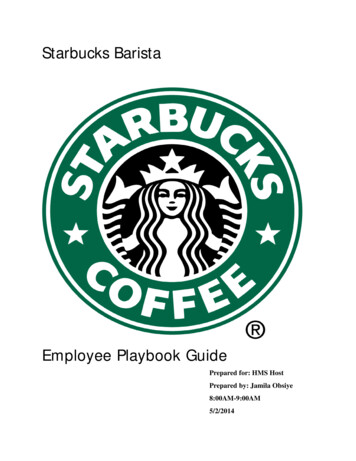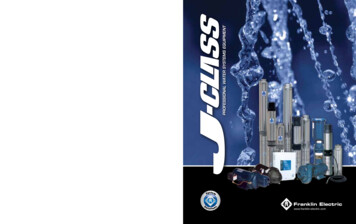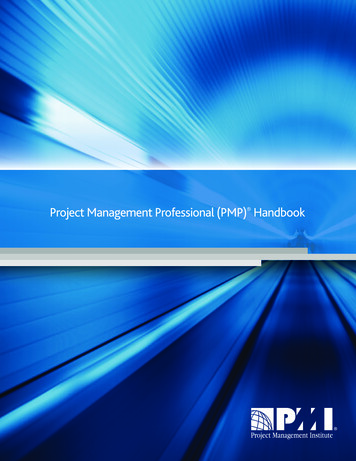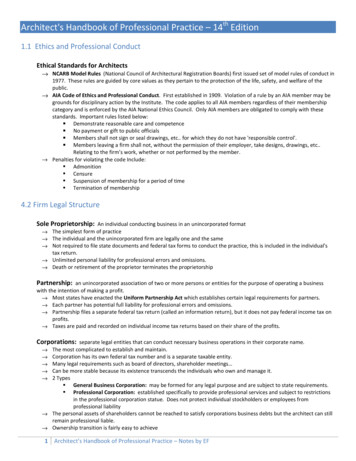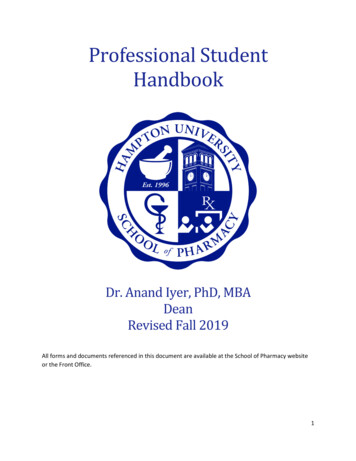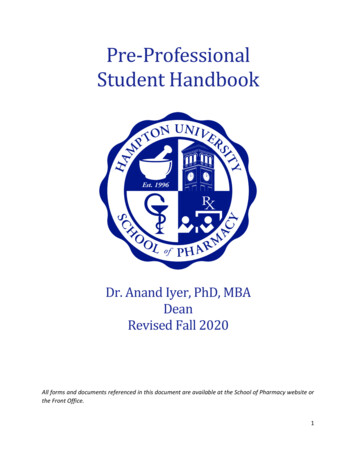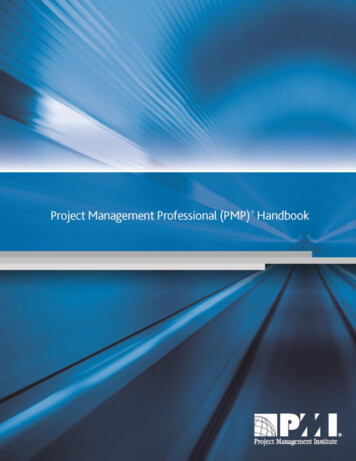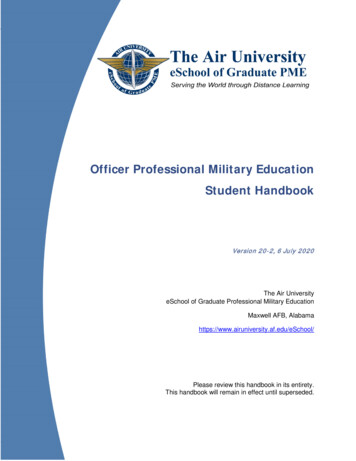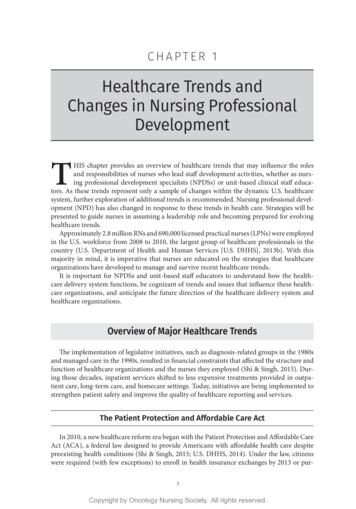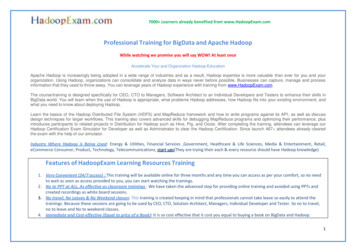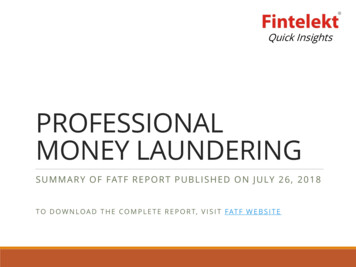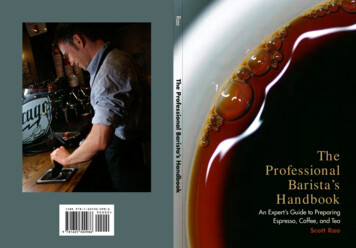
Transcription
RaoThe Professional Barista’s HandbookTheProfessionalBarista’sHandbookAn Expert’s Guide to PreparingEspresso, Coffee, and TeaScott Rao
ContentsIntroductionxi1. Getting Started12. Espresso 3Espresso Percolation: a PrimerGrinding for EspressoDosing and DistributionGroomingTampingWater TemperaturePutting It All TogetherPreinfusionEspresso-Making Techniques in Italy Versus AmericaPressure Interruptions During Espresso Brewing3. The Science and Theory of Percolation and ExtractionPercolation DynamicsFinesBasket Shape and ExtractionEspresso Brewing Ratios and Standards4. Milk 45Milk SteamingMilk Pouring5. Barista Systems 61Efficiency Enhancement ToolsWorkflow6. Drip Coffee 67FreshnessDrip Brewing StandardsGrindingTemperatureTurbulence35
Optimizing Different Batch SizesCoffee Brewing ChartSetting Up the FilterStirring: the Key to Making the Best Drip CoffeeProgrammable Brewer SettingsHow to Hold Brewed CoffeeBrewing Drip Coffee to OrderCoffee Filter TypesFreezing Coffee BeansIntroduction7. French Press Coffee 79How to Make Great French Press Coffee8. Water 81Water Chemistry 101Brewing Water StandardsWater TreatmentDescaling9. Tea 87Basic Tea-Making GuidelinesPreparation by Tea TypeAppendix91ReferencesGlossaryIndexWhen I began in the coffee business fourteen years ago, I read every book I couldfind about coffee. After reading all of those books, however, I felt as if I hadn’tlearned much about how to make great coffee. My coffee library was chock-full ofcolorful descriptions of brewing styles, growing regions, and recipes, with a fewalmost-unreadable scientific books mixed in. I would have traded in all of thosebooks for one serious, practical book with relevant information about making greatcoffee in a café.Fourteen years later, I still haven’t found that book. I know many other professionals as well as some obsessive nonprofessionals would like to find that samebook I’ve been looking for. This book is my attempt to give it to them.939599Chapter Titlexi
The BasicsEspresso is produced by the percolation of pressurized hot water through a tightlypacked bed of finely ground coffee. The water erodes solids and oils from the surfaces of the coffee particles as it flows through the coffee bed and deposits the solidsand oils in the cup.The flow rate of the water through the grounds is determined primarily by theamount of pressure applied by the machine, the mass of the grounds, and the fineness of the grind. Higher pressure, up to a point, increases the flow rate; beyondthat pressure, flow rate decreases. A larger dose or a finer grind produce greaterflow resistance and a slower flow rate.Water always follows the path of least resistance through the coffee bed; it isthe barista’s job to create not only the proper amount of flow resistance, but also toform the coffee bed such that it provides uniform resistance to the water. A poorlyformed coffee bed is vulnerable to the creation of a channel, an area of high-velocityflow through the coffee bed.Channels are detrimental to brew strength and flavor. The large volume of waterflowing through a channel dilutes the shot and causes the grounds along the channel to overextract,* increasing bitterness. Because less water passes through thedenser areas of the coffee bed, those areas underextract,* resulting in underdeveloped flavors and lower brew strength. To minimize channeling, a barista shouldprepare a bed of grounds so it has a smooth and level surface, forms a tight seal withthe wall of the portafilter basket, and is of uniform density.Evidence of channeling can sometimes, but not always, be seen when using abottomless portafilter. Channeling is indicated when extract flows more rapidly oryellows more quickly from some areas of the basket than others.The Barista’s RoleWhen preparing an espresso, a barista’s basic goals should be to: Create a dose of consistent mass every shot. Choose the grind setting that will provide the desired flow resistance. Distribute the dose evenly to provide uniform resistance to the water. Tamp with enough pressure to eliminate void spaces within the coffee bed andto seal the surface of the bed. Ensure the brewing water is of the desired temperature. Complete all of these tasks efficiently.The Grinder’s RoleThe grinder is the most important piece of equipment in an espresso bar. Grinders are usually overshadowed by more expensive, flashier espresso machines, butThe yellow extract on the left indicates channeling.grinder quality is arguably the single most important factor in preparing a greatespresso.A quality grinder must: Produce the proper particle sizes to provide adequate flow resistance. Create a bimodal or trimodal distribution of particle sizes. (See “Grinding forEspresso” in Chapter 2.) Cause minimal heating of the grounds during grinding. Limit the production of fines.Fines play many important roles in espresso percolation; these will be discussedin detail in Chapter 3. For now it is important to know that the brewing water cantransport and deposit fines lower in the coffee bed during percolation, a phenomenon known as fines migration. When fines and large insoluble protein moleculesare deposited at the bottom of the coffee bed they can form a compact layer,1 ordensely packed solid mass. A compact layer clogs holes at the bottom of the filterbasket and can result in obstruction of flow paths, uneven resistance to flow, andchanneling. It is desirable to have some fines, but too many fines or too much finesmigration can damage espresso quality.The Espresso Machine’s Role* The terms “overextract” and “underextract” are subjective; by using them I do not mean to implythere is a universally agreed-upon ideal level of extraction for coffee, tea, or espresso. Instead, thereader should interpret overextraction as a general reference to extracting more than the intendedamount, usually to the point of excessive bitterness or astringency. Underextraction is meant toindicate less extraction than intended, usually such that the resulting beverage has insufficientflavor development. EspressoThe espresso machine’s task is to deliver water to the grounds in a predeterminedpattern of temperatures and pressures. These patterns are known as temperatureprofiles and pressure profiles.A quality espresso machine should be able to produce consistent temperatureand pressure profiles every shot, even under heavy use.Espresso
The Dynamics of Espresso Percolation and ExtractionKeyExtractFinesWaterChannelLOW PRESSURE WETTINGT -1 secondDRYT -10 secondsFULL PRESSURE & FIRST EXTRACTT 0 secondsMID-EXTRACTIONT 15 secondsAccording to the research done with large percolator columns, diffusion doesnot occur until coffee particles are:1. “Satisfied with bound water.” Coffee particles can hold up to about 15% oftheir dry weight as bound water.162. Saturated with free extracting liquid.73. Free of gases.7The typical espresso extraction time is probably too short for all three preconditions of diffusion to be met. Therefore, it is likely that espresso extraction is accomplished entirely by the washing of solids from the outer surfaces of coffee particles,as well as by the emulsification* of oils.9 Diffusion plays little, if any role.BEGINNING OF EXTRACTIONT 5 secondsLATE EXTRACTIONT 25 secondsThe color of the grounds (represented by the stacked rectangles) in the first frame is deep red,indicating they are concentrated with coffee solids. The lighter reds in later frames representlower solids concentrations.T -10 seconds: The dry grounds just before the pump is engaged. The grounds are packedwith solids, and fines are scattered throughout the coffee bed.T -1 second: The coffee bed near the end of preinfusion. The water has percolated throughalmost all of the coffee bed but extraction has not yet begun. The grounds have absorbedwater, swelling the coffee bed. A channel, represented by the yellow line, has formed throughthe middle of the coffee bed. The upper layers of the coffee bed have lost solids, while thelower coffee bed has gained solids. Fines have begun to migrate down the coffee bed.T 0 seconds: The first extract appears. The first extract appears at the outlet of the channel.Fines and solids have concentrated in the lower layers of the coffee bed. The coffee bed contracts as pressure increases.T 5 seconds: Early extraction. Solids and fines are rapidly removed from the coffee bed. Thecoffee bed is further compressed as full pump pressure is applied.Flow ProgressionThe initial extract from the flow of a well-prepared shot should be viscous anddark.‡ As the flow progresses the extract becomes more dilute and the color gradually lightens, eventually turning yellow. Cutting off the flow when it yellows, orT 15 seconds: Mid-extraction. The coffee bed shrinks as it loses mass. The upper layers ofthe bed are almost depleted of extractable solids. The bulk of fines and solids are concentratedin the lowest layers of the bed.* The emulsification of oils seems to be enabled by the pressure of espresso brewing. It is arguablethat the emulsion is the aspect of an espresso most responsible for differentiating it from a veryconcentrated cup of coffee.T 25 seconds: Final moments of extraction: The upper layers of the bed are completely emptyof extractable solids. The coffee bed has lost about 20% of its original dry mass.‡ The color of the extract is believed to be darker when it has a higher concentration of caramelizedsolids or a lower concentration of CO2, though there may be other factors that influence color.38The Science and Theory of Percolation and ExtractionThe Science and Theory of Percolation and Extraction39
How to Pour Latte ArtTo pour latte art you must have a fresh shot of espresso with a reasonable amountof crema and properly textured steamed milk. The milk should look creamy andglassy, with no visible bubbles.The most common mistakes beginners make are pouring the milk too slowlyand lifting the pitcher away from the surface of the beverage while pouring. Pouringmilk too slowly can cause it to separate in the pitcher, causing less-aerated milk topour into the beverage and more-aerated milk to remain in the pitcher. This makespouring latte art difficult and also results in an under-aerated beverage. Raisingthe pitcher away from the surface of the beverage causes the milk to dive under thecrema rather than resting on top of the crema and forming a design.Begin by pouring the milkinto the center of the crema.Pour quickly enough toprevent separation in thepitcher but slowly enough tokeep the crema intact.Maintain a consistent,moderate flow rate throughout the entire pour. To dothis, you must accelerate thetipping motion of the pitcheras the amount of milk in thepitcher decreases.Rock the pitcher back andforth once the white cloudappears.Raising the pitcher while pouring prevents the milk from resting on the crema becausethe flow of the milk is accelerated by gravity. Raising the pitcher is analogous to divingfrom a high board: just as the milk dives to the bottom of the cup and hardly disturbsthe crema, the diver cuts through the surface of the water with hardly a ripple andsubmerges deeply. On the other hand, pouring with the spout of the pitcher kept veryclose to the surface of the beverage is analogous to diving from the edge of a pool:the milk skims the surface of the beverage just as the diver merely skims the surfaceof the water.The Spoon MethodContinue rocking the pitcherto create a zigzag pattern. Itis critical to resist the urge toraise the pitcher away fromthe surface of the beverage.It may be counterintuitive,but keep the pitcher as lowas possible while pouringand constantly acceleratethe tipping of the pitcher tomaintain the flow rate.50Back the pitcher toward theedge of the cup while zigzagging. Once you reachthe edge of the cup lift thepitcher a couple of inchesand drizzle a small streamof milk back across the centerline of the zigzags.The spoon method is common in New Zealand, but I’ve yet to see it practiced elsewhere. The benefits of the spoon method include delaying froth separation in thecup and allowing control over the texture of the milk while pouring. The disadvantages of the spoon method are it takes more time than free-pouring, requires theuse of both hands, and is harder to master.The spoon method works best with a round bell or vev pitcher with a bevelededge. The wide mouth of the bell pitcher provides a better view of the milk texturewhile pouring and allows easier spoon access and control.To execute the spoon method, steam the milk, groom it if necessary, and use atablespoon as a gate to control the flow and texture of the milk as it is poured. Thedetails are different for each drink, but the basics are the same.1. Begin the pour with the spoon tightly restricting all but the densest, leastfrothy milk. Some baristi use the spoon to pull back (away from the pouringedge) the frothiest milk several times before restricting the milk and starting the pour.2. Pour into the center of the espresso at a moderate rate to prevent breakingup the crema.3. While pouring, lift the spoon slowly to allow frothier milk into the cup.4. The surface of the finished drink should be glassy and can be finished witha design if desired.Ecco!MilkMilk51
How to Milk-ShareTransfer about 1 3 of the milk from the large pitcherto the small pitcher.Spin the large pitcher to check the milk texture before pouring.Free-pour the cappuccino milk using the large pitcher.56Combine remaining milk in the small pitcher.Spin the milk in the small pitcher. Groom ifnecessary.Pour the café latte.MilkMilk57
The BasicsIt is common knowledge that brewing water should be carbon filtered and have no“off” flavors. But that is only the starting point for quality brewing water. To get themost out of your coffee (or tea or espresso), the water needs to have a neutral pHand appropriate levels of hardness, alkalinity, and total dissolved solids (TDS).The following wate
colorful descriptions of brewing styles, growing regions, and recipes, with a few almost-unreadable scientific books mixed in. I would have traded in all of those books for one serious, practical book with relevant information about making great coffee in a café. Fourteen years later, I still haven’t found that book. I know many other profes- sionals as well as some obsessive .
